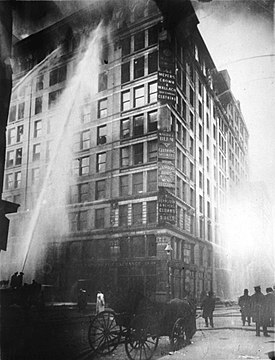 | |
| Date | March 25, 1911 |
|---|---|
| Time | 4:40 p.m. (Eastern Time) |
| Location | Asch Building, Manhattan, New York, U.S. |
| Coordinates | 40°43′48″N 73°59′43″W / 40.73000°N 73.99528°W |
| Deaths | 146 |
| Non-fatal injuries | 78 |
The Triangle Shirtwaist Factory fire in the Greenwich Village neighborhood of Manhattan, New York City, on Saturday, March 25, 1911, was the deadliest industrial disaster in the history of the city, and one of the deadliest in U.S. history.[1] The fire caused the deaths of 146 garment workers—123 women and girls and 23 men[2]—who died from the fire, smoke inhalation, falling, or jumping to their deaths. Most of the victims were recent Italian or Jewish immigrant women and girls aged 14 to 23;[3][4] of the victims whose ages are known, the oldest victim was 43-year-old Providenza Panno and the youngest were 14-year-olds Kate Leone and Rosaria "Sara" Maltese.[5]
The factory was located on the 8th, 9th, and 10th floors of the Asch Building, which had been built in 1901. Later renamed the "Brown Building", it still stands at 23–29 Washington Place near Washington Square Park, on the New York University (NYU) campus.[6] The building has been designated a National Historic Landmark and a New York City landmark.[7]
Because the doors to the stairwells and exits were locked[1][8]—a common practice at the time to prevent workers from taking unauthorized breaks and to reduce theft[9]—many of the workers could not escape from the burning building and jumped from the high windows. There were no sprinklers in the building.[10] The fire led to legislation requiring improved factory safety standards and helped spur the growth of the International Ladies' Garment Workers' Union (ILGWU), which fought for better working conditions for sweatshop workers.
- ^ a b "The Triangle Shirtwaist Factory Fire". OSHA. Retrieved June 10, 2015.
- ^ "Sweatshop Tragedy Ignites Fight for Workplace Safety". APWU. February 29, 2004. Retrieved January 23, 2021.
- ^ Kosak, Hadassa. "Triangle Shirtwaist Fire". Jewish Women's Archive. Retrieved June 11, 2019.
- ^ Stacy, Greg (March 24, 2011). "Triangle Shirtwaist Fire Marks a Sad Centennial". Online Journal. Archived from the original on May 18, 2011. Retrieved June 11, 2019.
- ^ Von Drehle, David. "List of Victims". History on the Net. Archived from the original on February 13, 2013. Retrieved November 28, 2012.
- ^ "23 Washington Place, Manhattan" New York City Geographic Information System map
- ^ Gale Harris (March 25, 2003). "Brown Building (formerly Asch Building) Designation Report" (PDF). New York City Landmarks Preservation Commission. Archived from the original (PDF) on August 7, 2012. Retrieved February 6, 2012.
- ^ Lange 2008, p. 58
- ^ Cite error: The named reference
Liffwas invoked but never defined (see the help page). - ^ The Century: America's Time - The Beginning: Seeds of Change (DVD). ABC News. 1999. Event occurs at early 1900s. Retrieved February 12, 2024.
There were no sprinklers inside the factory then; There had never been a fire drill.